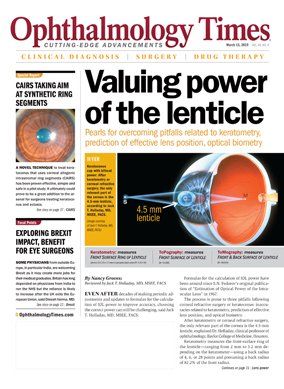Publication
Article
Digital Edition
Build a better work environment in 4 easy steps
Author(s):
Supportive leadership creates a culture that benefits your whole team.

Do you want better days? Here's how you can improve in 4 easy steps!
Editor’s Note: Welcome to “Eye Catching: Let's Chat,” a blog series featuring contributions from members of the ophthalmic community. These blogs are an opportunity for ophthalmic bloggers to engage with readers with about a topic that is top of mind, whether it is practice management, experiences with patients, the industry, medicine in general, or healthcare reform. The series continues with this blog by Donna Suter, president of Suter Consulting Group. The views expressed in these blogs are those of their respective contributors and do not represent the views of Ophthalmology Times or UBM Medica.
"I want better days." This line from an episode of “The Good Doctor” holds the key to your success as a practice owner. I suggest that the following are as true for you as they were for the characters in the episode, titled “Aftermath.”
- You want to be respected as a doctor and your day shines a little less bright when someone second-guesses your decisions.
- You aren’t really ‘friends’ with all of your co-workers, but it would be nice to ‘do lunch’ together.
- You feel like you don’t really have any close friends. No one you can have a big belly laugh with or be silly.
- You feel you’re forced into putting work and patient care in front of important personal relationships.
If the show writers of this series can resolve these heavy emotions you are feeling in 50 minutes, this writer can offer corresponding rules and guidance in 1,200 words or less.
Rule #1- If it wasn’t documented, it wasn’t performed!
Be careful of “cloning” previous visits, “pulling forward,” or defaulting all fields to “normal” when charting patient care.
Proper charting documentation is crucial. There is a difference between wellness coverage vs. medical visits, and the way these are charted may be reviewed, as OIG has identified this as a target area for audits. The move toward expanded “wellness” coverage that began several years ago has become a sweeping trend. It’s a great trend and prevents preventable blindness.
A quick internet search will show that health plans are encouraging their members to include the use of the benefit as part of their preventative routine each year. The challenge is for those of you who are seeing wellness visits from those who are diabetic or glaucoma candidates, which can morph into more than a wellness check.
Establish triage guidelines and how to communicate your intentions to either diabetic or glaucoma candidates using wellness eye benefits or diabetic or glaucoma patients returning for medical exams as part of their follow-up care.
Asking for copays and deductibles should not be a big emotional hurdle for employees. Being properly paid for your complex problem-solving abilities and medical acumen is paramount to practice success.
Rule #2– Lunch with the boss is never just ‘lunch’
There is a lot that goes into running a practice, a great deal of which is the help you get from others. While leadership as a discipline is very, very important, the personal and interpersonal sides of leadership are every bit as important as the great leadership themes of vision and/or execution, strategy, and the like.
For what actually happens is that no matter how great a vision or a strategy is, the doctor must get it all done with and through people.
And that is where lunch comes in. You have to find your way. I want you to be friends with employees without employees taking advantage of you. Sadly, I could write a pretty thick book about stolen money, stolen time and stolen ophthalmic product. And each true story would end with “… and I thought he/she was my friend.”
Build a culture that allows employees to feel appreciated-it has more to do with success than your business acumen.
People’s hearts and minds are constructed to perform best under certain conditions. No pressure, but they all depend on your style and behavior. For your team, it might be lunch that brings ‘the secret sauce’ to practice dynamics.
Rule #3– Boundaries are for leaders
I’m not really sure your bestie should be someone who works for you. Henry Cloud, PhD, writes in his self-help books about boundaries. According to Dr. Cloud, a boundary is a structure that determines what will exist and what will not-so keep this thought in mind.
Success magazine named Dr. Cloud as one of the top 25 of 2014’s most influential leaders in personal growth and development. He is a frequent contributor to CNN, Fox News Channel, and other national media outlets. Folks, he is a rock star and we all should take advantage of his wisdom.
Rule #4 – You always get what you create and what you allow
This is a quote Dr. Cloud uses a lot; but I heard it first from another and somewhat lesser-known psychologist, Nancy Martin, PhD. Dr. Martin showed me that how I carried myself taught others how to treat me in about 15 minutes. This great woman helped me learn to coach without being bossy and share criticism without shattering egos.
Most importantly, she taught me the same communication basics that (ones that Dr. Cloud also uses)-on how to pick up the pieces when we mess up. Part of gaining all this communications expertise is learning how to say you are sorry and forgive yourself. You have to accept that it takes time to allow yourself to retrain its neuropathways. Be patient with yourself.
Another personal friend that helped me and can help you too is Beverly Inman-Ebel, MA, CCC-SLP. She wrote a book that I really do think I can quote from memory. “Talk is Not Cheap, Saving the High Cost of Misunderstanding at Work and Home.” Beverly, whom I am honored to call my friend, wrote a book proving that it is possible to never upset anyone by miscommunicating. (I know what you are thinking: She has never been to your practice during a full moon.)
That full moon and all my brilliant clients who trust me to retool their communication patterns are the reasons I keep reading and applying her excellent strategies and tactics to real-life situations.
956 Words
When you make a financial investment in stocks or mutual funds, you can see the return. If you invest well, the return on being a better communicator is positive. (I shared insights on how to have more good days in just 956 words.) When the investment climate is bullish or soft, knowing you are investing wisely means a greater peace within because of your internal positive attitude.
There is a tremendous personal power in knowing you control your attitude. It rings a balance that creates a harmony which allows you to handle the practices ups and downs.
Support is important. Having a supportive friend not in the practice is a valuable connection. Later, you will be one radiating success. A rewarding and pleasurable career grows from your meaningful achievements. Small steps achieved through becoming a leader that creates a culture that supports your team.
When people exclaim that they just don’t know how you do it all, tell them it all started with wanting to have more “good days.”

Newsletter
Don’t miss out—get Ophthalmology Times updates on the latest clinical advancements and expert interviews, straight to your inbox.




